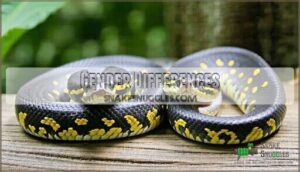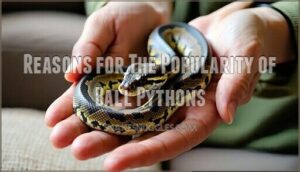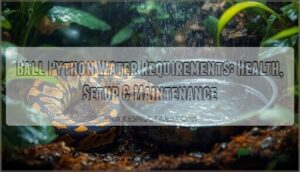This site is supported by our readers. We may earn a commission, at no cost to you, if you purchase through links.

Young ball pythons grow about 8-12 inches in their first year, reaching 2-3 feet by age two or three.
Captive care, diet, and habitat quality affect how they develop, so ask for records if you bought it at a pet store.
Wild ball pythons often grow slower due to limited food.
Adults typically live 20-30 years in captivity with proper care, and it’s not an exact science, but these clues can give you a ballpark figure—and there’s more to uncover about their life stages, which is crucial for providing the best possible care.
Table Of Contents
- Key Takeaways
- How to Estimate a Ball Python’s Age
- Factors Affecting a Ball Python’s Lifespan
- Understanding When a Ball Python Reaches Adulthood
- Reasons for The Popularity of Ball Pythons
- The Life Cycle of a Ball Python
- Common Medical Issues in Ball Pythons
- Maintenance and Care to Prolong a Ball Python’s Lifespan
- Frequently Asked Questions (FAQs)
- How many years can a Ball Python Live?
- When is a ball python considered an adult?
- Is my ball python overweight?
- How can I tell the age of my ball python?
- How long do ball pythons live as pets?
- Can you leave a heat lamp on 24/7 for ball python?
- At what age is a ball python full grown?
- How can I tell how old my ball python is?
- How long does a ball python live in captivity?
- What is the average lifespan of a ball python?
- Conclusion
Key Takeaways
- You can estimate your ball python’s age by measuring its size, weight, and physical traits, and comparing them to known growth milestones.
- Ball pythons usually grow to 3-6 feet by adulthood, with males being smaller than females, and reach full size around 3-4 years.
- Captive ball pythons live 20-30 years with proper care, including suitable enclosures, balanced diets, and regular health checks.
- Maintain appropriate temperature, humidity, and feeding schedules to ensure healthy growth and longevity for your python.
How to Estimate a Ball Python’s Age
You can estimate a ball python’s age by evaluating its size, weight, and physical traits. Comparing these factors to known growth patterns provides a general age range.
Estimating a ball python’s age starts with observing size, weight, and traits—unlocking clues to its fascinating growth journey!
Growth Rate and Size Measurements
To estimate your ball python’s age, focus on size and weight milestones.
Growth slows after three years, but key stages include:
- Hatchling Size: 8–18 inches, 65–100 grams
- Juvenile Growth: 1.5–2.5 feet, 150–500 grams
- Adult Dimensions: 3–5 feet, 2–5 pounds
Use python growth charts to track length and weight by age.
You can also find products related to python size tracking.
Health Assessment
Checking your ball python’s health goes beyond size.
A proper health assessment includes monitoring physical examination signs like smooth scales and clear eyes.
Behavioral changes, such as reduced activity, might signal issues.
Watch hydration status—wrinkled skin can mean dehydration.
Regular shedding and healthy scale condition show growth.
Stay alert for common ailments like respiratory infections.
Consistent python health monitoring guarantees your snake thrives at every stage, ensuring proper health assessment and overall ball python’s health.
Pet Store Information
When shopping for a ball python, most pet stores like PetSmart typically stock snakes around 6-10 months old.
Prioritize sourcing ethics and health guarantees by thoroughly examining the snake’s enclosure quality and asking about its origin.
Verify husbandry practices, check temperature and humidity conditions, and seek expert advice to confirm you’re getting a healthy, well-cared-for reptile that meets your expectations.
Factors Affecting a Ball Python’s Lifespan
If you’re curious about how long your ball python might live, understanding the key factors that influence its lifespan is essential.
You’ll want to pay close attention to variables like habitat conditions, diet quality, genetic background, and whether your snake lives in the wild or captivity, as these elements can dramatically impact how many years your scaly companion will thrive.
Wild Vs. Captive Lifespan
The ball python lifespan varies greatly between wild and captive environments.
In the wild, natural threats like predators, disease, and food scarcity limit their lifespan to about 10 years.
Captive benefits, including controlled diets, consistent care, and optimized habitats, allow pet specimens to thrive for 20–30 years or more.
Understanding their genetic mutation origins can help owners appreciate the unique traits of different ball python morphs.
These python lifespan factors highlight the impact of captivity on their longevity, and the importance of controlled diets.
Gender Differences
Gender differences play a key role in a ball python’s lifespan expectancy. Females, due to their larger size and energy-intensive reproductive cycles, often have shorter lives than males.
Males, on the other hand, benefit from lower energy demands, especially during courtship. This size variance and weight differences highlight the growth disparity between the sexes.
Additionally, males tend to have smaller bodies and more prominent cloacal spurs, while females grow larger but mature more slowly.
Determining a ball python’s gender can be achieved through the probing method. Understanding this maturity timeline guarantees better care for both genders.
Conservation Status
Despite their Least Concern conservation status, wild populations face threats like habitat loss and illegal trade.
Here’s how conservation efforts can help:
- Protect habitats to combat environmental challenges.
- Regulate illegal trade for wild survival.
- Support breeding programs to reduce wild capture.
- Raise awareness about conservation initiatives.
Safeguarding these snakes guarantees their future in both wild and captive settings.
They’re known for their unique balling defense when stressed.
Understanding When a Ball Python Reaches Adulthood
Understanding ball python maturity means watching for key growth and behavioral changes. By 16–18 months, most ball pythons approach sexual maturity, with males often maturing slightly earlier.
Around 27–31 months, they reach breeding age, showing adult size and a more robust body shape. Behavioral changes, like increased activity during the breeding season, signal python adulthood.
Here’s a quick breakdown:
| Age | Length | Weight |
|---|---|---|
| Hatchling | 10–16 inches | 65–100 grams |
| 1 Year Old | 2 feet | 400–600 grams |
| 2 Years Old | 2.5–4 feet | 500–1,000 grams |
| 3+ Years (Adult) | 3–6 feet | 1,200–2,300 grams |
| Full Adulthood | Growth Plateau | Stable Weight |
Providing proper care guarantees healthy python adulthood and readiness for breeding.
Reasons for The Popularity of Ball Pythons
Ball pythons are a favorite among snake enthusiasts due to their calm nature, easy handling, and suitability for beginners.
Known for their calm demeanor and ease of care, ball pythons are perfect companions for both beginners and experienced snake keepers.
Their manageable size and straightforward care requirements make them an ideal choice for both new and experienced reptile owners, with easy handling being a significant advantage.
Docile Temperament Appeal
Thanks to their docile temperament, ball pythons are a gentle snake that’s easy to handle, even for beginners.
Their calm nature and reduced aggression make them a perfect family pet.
You’ll find their beginner-friendly care appealing, especially if you’re new to reptiles.
Combined with their manageable size, they’re a stress-free choice for anyone exploring snake ownership in general.
Manageable Size Benefits
A ball python’s manageable size—3 to 5 feet—offers easy handling and safer interaction, especially for beginners.
Their limited space needs mean smaller enclosures, reducing costs and simplifying ball python care.
Portability benefits make them ideal for homes with space constraints.
Regular monitoring guarantees their growth aligns with typical ball python age milestones, supporting their health and beginner-friendly care.
Beginner-Friendly Care
Caring for a ball python is straightforward, making them a top choice for beginners.
Their easy handling means they’re calm and adapt well to regular interaction.
Feed them every 1-2 weeks based on their ball python growth rate.
Provide a safe enclosure: juveniles thrive in 20-gallon tanks, adults in 40-gallon ones.
- Maintain ideal temperatures (75-85°F) and practice basic hygiene to guarantee their long ball python life expectancy.
The Life Cycle of a Ball Python
A ball python’s life cycle includes distinct growth phases, from hatchling to adulthood.
Each stage is marked by changes in size, weight, and behavior, helping you track their development over time, which can be considered a complete concept to understand their growth.
Development and Reproduction
Breeding age marks a significant milestone in a ball python’s life. Females, reaching sexual maturity around 2-3 years, play a key role in the python breeding process.
After mating, their incubation period lasts 44-54 days. During this time, they carefully select nesting sites to guarantee reproductive health and breeding success.
Here’s a quick breakdown:
| Aspect | Detail |
|---|---|
| Breeding Age | 2-3 years (females) |
| Clutch Size | 1-11 eggs |
| Incubation Period | 44-54 days |
| Reproductive Health | Site selection critical |
| Breeding Success Decline | Older females may lay fewer eggs |
This strategy guarantees survival, even in the wild. A typical clutch size ranges from 1-11 eggs, which stick together for added protection.
Hatching and Growth
After hatching, baby ball pythons use their egg tooth to break free, measuring 25–43 cm in hatchling length.
Early growth is rapid, with noticeable changes in size and weight during the hatchling and juvenile growth stages. Monitoring their growth rate helps you adjust diet and habitat needs effectively.
Regular weighing guarantees proper subadult development, leading to a healthy adult size. Understanding ball python growth stages is key to managing their care and tracking their baby ball python age accurately.
To guarantee healthy development, it’s essential to maintain proper humidity levels.
Common Medical Issues in Ball Pythons
Keeping your ball python healthy means understanding common medical issues they might face.
Respiratory infections, shedding problems, prey bites, and serious conditions like Inclusion Body Disease can impact their well-being if not addressed promptly.
Respiratory Infections
Respiratory infections (RI) are one of the most common ball python health issues, often caused by poor enclosure conditions.
RI symptoms include wheezing, mucus around the nostrils, and open-mouth breathing, signaling your python isn’t comfortable.
Keep temperatures and humidity in the ideal range to prevent RI causes.
Prompt RI treatment, including a vet visit and adjustments to the enclosure setup, can lead to positive RI prognosis.
A vital part of maintaining proper humidity involves using a suitable humidity device.
- Maintain ideal temperatures and humidity.
- Keep the enclosure clean.
- Avoid overcrowding habitats.
- Provide fresh, clean water daily.
- Monitor for RI symptoms regularly.
Shedding Problems
Shedding problems in ball pythons, like stuck shed, often mean there’s an issue with their environment or health.
These problems can increase infection risks and discomfort.
Common causes include:
- Humidity levels: Keep it around 50-60% or slightly higher during shedding.
- Diet impact: Offer proper prey sizes to support healthy snake shedding.
- Stress: Limit handling during shed cycles to reduce stress.
Maintaining proper humidity is key, and you can find humidity control products to help.
By ensuring balanced humidity, proper feeding, and minimizing stress, your python’s shedding frequency will stay healthy and consistent.
Prey Bites
Prey bites can cause unexpected trouble during ball python feeding. These accidents often occur when a live prey item fights back, leading to injuries like puncture wounds or bleeding.
Infection risks add to the concern, especially if wounds aren’t cleaned promptly. To minimize this, always use feeding tongs and select appropriately sized prey. Avoid handling your python immediately after meals as agitation increases bite risks.
If bites happen, acting quickly is key. Clean the area thoroughly and monitor for swelling or discharge. Minor wounds usually heal well, but deeper injuries may require a vet. Ball pythons are also susceptible to dermatitis and skin irritation from unclean enclosures.
| Problem | Cause | Solution |
|---|---|---|
| Puncture wounds | Live prey defense | Use tongs, choose smaller prey |
| Infection risks | Unclean wounds | Clean wounds, apply antiseptic |
| Behavioral changes | Stress from improper handling | Handle confidently post-healing |
Inclusions Body Disease
Inclusion Body Disease (IBD) is a serious ball python health issue.
Symptoms like disorientation, regurgitation, and weakness need immediate attention. Early IBD diagnosis is essential to improve outcomes.
Follow these steps:
- Identify Symptoms: Watch for neurological issues, appetite loss, or difficulty breathing.
- Seek Veterinary Care: IBD treatment requires specialized diagnostics, like blood tests.
- Prevent Transmission: Isolate infected snakes and maintain strict hygiene.
Protect your python’s health!
Maintenance and Care to Prolong a Ball Python’s Lifespan
Keeping your ball python happy and healthy means you’ll need to focus on key areas of care. Start with Suitable Enclosures, like a 40-gallon tank for adults, offering enough room to explore.
Maintain Proper Hydration with humidity levels at 50-60% and guarantee the temperature stays between 75-80°F on the cool side and 88-92°F on the warm side. Feed pre-killed rodents every 1-2 weeks to promote Diet Variety while preventing injuries.
Minimize handling to support Stress Reduction, letting your python feel safe in its environment. Schedule Regular Checkups to catch issues like infections early.
With proper care, they can avoid many issues that affect their lifespan, and can even exceed the typical lifespan range. A clean home, balanced diet, and reduced stress guarantee lifespan extension, giving your python 20+ years of companionship.
| Factor | Ideal Target | Notes |
|---|---|---|
| Enclosure Size | 40 gallons+ | Adults need space to roam |
| Humidity | 50-60% | Avoid shedding issues |
| Cool Side Temp | 75-80°F | Ideal for resting |
| Warm Side Temp | 88-92°F | Supports digestion |
| Feeding Cycle | Every 1-2 weeks | Pre-killed rodents only |
Frequently Asked Questions (FAQs)
How many years can a Ball Python Live?
Don’t worry, you’re in it for the long haul.
With proper care, a ball python can live 20 to 30 years in captivity.
Their longevity depends on diet, environment, and regular veterinary care.
When is a ball python considered an adult?
A ball python is considered an adult at about 3 years old.
By this age, they’ve reached their full size, with males typically smaller (3-4 feet) and females larger (4-6 feet).
Is my ball python overweight?
If your ball python looks round when viewed from above, like a loaf of bread instead of a healthy tube shape, it might be overweight.
Weigh it and compare against standard weight ranges for reassurance.
How can I tell the age of my ball python?
You can estimate your ball python’s age by measuring its length and weight.
Younger pythons grow quickly, reaching adult size after 3 years.
Bright patterns, faded colors, or head size can help identify age too, with complete concepts like these being essential for accurate estimation.
How long do ball pythons live as pets?
Imagine a well-tended garden thriving for decades—ball pythons, with good care, live 20-30+ years in captivity.
Proper diet, enough warmth, and care are key to their long, healthy, and happy lives.
Can you leave a heat lamp on 24/7 for ball python?
You shouldn’t leave a heat lamp on 24/7 for a ball python.
They need a day-night cycle to mimic natural conditions.
Use a timer or switch to guarantee consistent, healthy temperature regulation and rhythm.
At what age is a ball python full grown?
Think of a ball python like a slow-growing tree.
They typically reach full size around 3-4 years old.
Males stop at about 3-4 feet, while females grow larger, reaching 4-6 feet.
How can I tell how old my ball python is?
Check your ball python’s size, weight, and behavior.
Young snakes are smaller, more vibrant, and active.
Adults grow 3-5 feet and weigh 2-5 pounds.
Faded colors or sluggishness suggest an older python.
How long does a ball python live in captivity?
With proper care, a ball python’s life in captivity can feel like flipping through a long, cherished photo album.
They often live 20-30 years, thriving with clean habitats, regular checkups, and the right diet.
What is the average lifespan of a ball python?
Ball pythons typically live 20-30 years in captivity with good care, but some reach over
A healthy diet, proper housing, and regular vet checkups help them enjoy their long, content lives.
Conclusion
Understanding your ball python’s age is like revealing the story of its life.
By tracking its growth, evaluating its health, and considering care conditions, you can estimate its age and guarantee it thrives.
Captive ball pythons can live 20-30 years with proper care, so providing the right environment, diet, and attention is key to supporting a long, healthy lifespan.
Whether observing its size or reviewing past records, these clues help you decode your snake’s age while supporting a long, healthy lifespan.
- https://www.quora.com/How-old-do-ball-pythons-get
- https://www.wilbanksreptiles.com/blogs/ball-pythons/a-comprehensive-guide-to-pied-ball-python-for-beginners?srsltid=AfmBOooSgM89rJaYUye0VFT9mkcCGVXudR-Ui83wmylxadWlkLnuljkg
- https://neobiota.pensoft.net/article/90439/element/4/4242/
- https://www.researchgate.net/publication/283685551_Captive_Reptile_Mortality_Rates_in_the_Home_and_Implications_for_the_Wildlife_Trade
- https://en.wikipedia.org/wiki/Ball_python
















